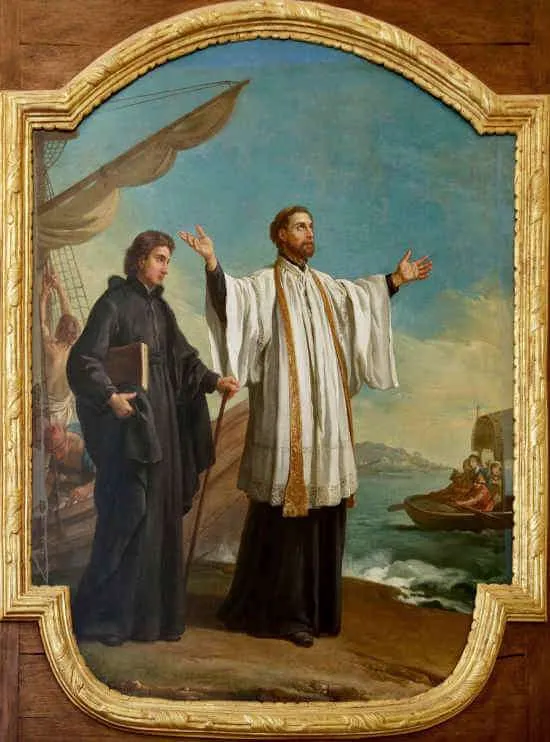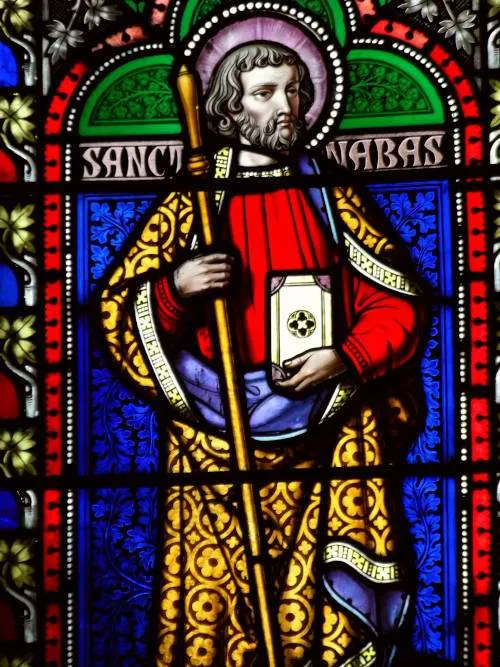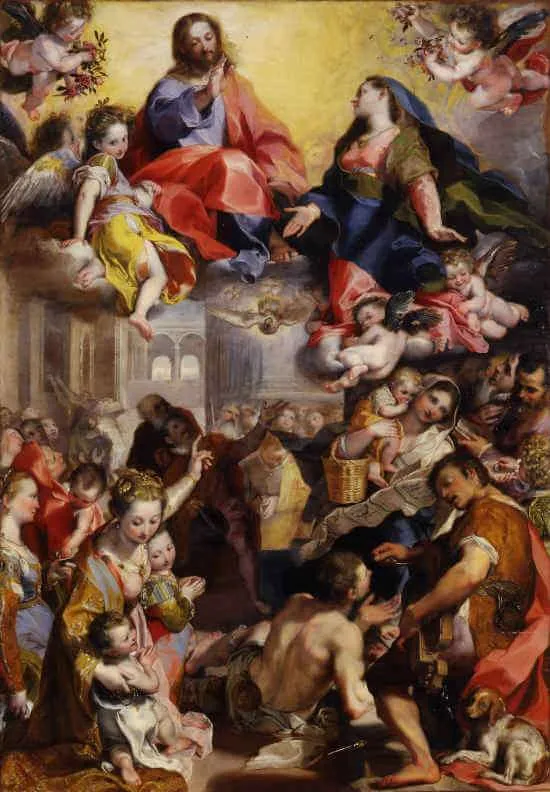1506–1552; Patron Saint of foreign missions, missionaries, navigators, and parish missions; Invoked against plague epidemics; Canonized by Pope Gregory XV on March 12, 1622
Francisco de Jasso y Azpilicueta (Francis) was born into a noble family at the Castle of Xavier in the Kingdom of Navarre, the youngest of several children. His father was seneschal (administrator) to the royal court of the King of Navarre, giving him important administrative, financial, and judicial authority. In 1512, when Francis was six, the King of Aragon and regent of Castile attacked the Kingdom of Navarre, with devastating consequences for Francis’ family’s wealth and power. Three years later, Francis’ father died. At the age of nineteen, Francis moved to Paris to study philosophy and the arts. As was common at that time, he went by the name Francis Xavier, identifying himself with his place of origin, the Castle of Xavier.
Francis entered the University of Paris with secular ambitions. After being at the university for four years, Francis and his roommate, Peter Favre, welcomed a new student who was fifteen years older: Ignatius of Loyola. Ignatius had moved to Paris to study theology in preparation for priestly ordination after experiencing a radical conversion. After his conversion, Ignatius began to write down his experiences in what would become one of the greatest programs of conversion ever written: The Spiritual Exercises of Saint Ignatius of Loyola. After becoming roommates with Peter and Francis, Ignatius worked on the two men, attempting to convert them and encouraging them to join him in a new religious society he desired to form. Peter was receptive, but Francis was not. Through Ignatius’ persistence, Francis’ heart underwent conversion, and he sensed a call to embrace the priestly ministry.
After four years of study, Francis earned a master’s degree in 1530 and began teaching at the university. Four years later, Ignatius and six companions, including Francis, embraced a common mission to consecrate themselves to God and to live as companions. On the hill of Montmartre, overlooking the city of Paris, these seven men made private vows of poverty, chastity, and obedience to the Roman pontiff, with a commitment to convert the infidels in the Holy Land. Following these private vows, Francis spent the next three years studying theology before his ordination as a priest in 1537, at the age of thirty-one. Together with his companions, Ignatius drew up a formal rule of life for their new company in 1539, which was approved by Pope Paul III the following year, formally establishing the Society of Jesus, later referred to as the Jesuits, which means “Companions of Jesus.”
Central to Jesuit spirituality are Saint Ignatius’ Spiritual Exercises, based on his own conversion. Francis Xavier was among the first to use the exercises to deepen his prayer life and communion with God. The exercises, along with the spiritual support and encouragement from his brothers—especially Ignatius—transformed him into one of the greatest missionaries in the history of the Church.
During his first three years as a priest, Father Francis Xavier cared for the poor and sick and deepened his prayer life, first in Venice and then in Rome. Decades earlier, Portuguese explorers had captured and colonized Goa, a city on India’s western coast. In 1540, the King of Portugal, upon hearing reports of immoral behavior among the Portuguese colonizers of Goa, petitioned the pope to send missionaries to Goa to assist. Seeing that the Society of Jesus was newly formed and young, the pope identified the Jesuits as the ideal group to send. Upon receiving the request, Father Ignatius of Loyola chose two of his first companions for the mission. When one became ill, Ignatius chose Father Francis instead, sending him to Portugal to have an audience with the king and queen. In 1541, at the age of thirty-five, after being named apostolic nuncio to the East by the pope, Father Francis and two Jesuits companions set sail to Mozambique and then to Goa, arriving on May 6, 1542.
For the next ten years, Father Francis’ missionary activity of traveling, preaching, converting, catechizing, building churches, baptizing, and miracle working were so extensive that he has since been referred to as another Saint Paul and the “Apostle to the East.” In 1904, Pope Pius X named him the patron saint of foreign missions. In addition to his ordinary missionary work of preaching, teaching, and administration of the Sacraments, stories abound about Father Francis healing the sick, calming a storm at sea, raising the dead, and preaching in tongues, a charism which enabled him to preach in his language while others heard him in their language.
Upon arriving at his first mission in Goa, Father Francis and his companions ministered to the Portuguese settlers. Though a bishop and diocesan priests were present, there was a need for preachers who would call the people to repentance. He began by tending the sick, which won the esteem of the people. He also called the children to himself by walking through town ringing a bell, inviting them to follow him to the church where he taught them about Jesus. The children, in turn, shared the faith with their family and friends. After several months, Father Francis became aware of numerous indigenous people along the southern coast and on the southern tip of India who had been baptized years earlier but were never catechized and formed in the faith. In a desire to minister to these natives, Father Francis and local priests from the seminary in Goa traveled south, teaching, offering the sacraments, and building dozens of churches with the help of the natives. Many unbaptized were converted, and thousands were baptized on that two-year mission. Though many welcomed him, others fiercely opposed him. At times, attempts were made on his life, but he persevered.
Over his decade of missionary activity, Father Francis set up missions in Malacca, in modern-day Malaysia; the Spice Islands, in modern-day Indonesia; Cochin and the coastal areas of modern-day Kerala, India; and the island of Sri Lanka. In 1548, Father Francis wrote a letter to his Jesuit brothers in Europe saying, “All the Portuguese merchants coming from Japan tell me that if I go there I shall do great service for God our Lord, more than with the pagans of India, for they are a very reasonable people.” Father Francis took their advice and set sail for Japan, arriving on August 15, 1549, at Kagoshima, making him the first foreign missionary to reach that land. He was accompanied by a Japanese convert named Anjiro (whose Christian name was Paul), a fellow Jesuit priest, and a lay brother. After spending many months learning the Japanese language and translating the Gospel into Japanese, he was able to make a considerable number of converts. Father Francis’ initial success in Japan was due to the fact that he learned and respected the local customs and culture, allowing him to more effectively share the Gospel in a way that the Japanese would embrace. Because of his foundational effort, the Catholic faith grew to number over 300,000 Japanese converts within the next sixty-five years. Saint Francis Xavier later wrote about the Japanese people: “These are the best people so far discovered, and it seems to me that among unbelievers no people can be found to excel them.” By the end of the century, however, Japanese Christians had undergone decades of severe persecution and hundreds of thousands of martyrdoms, so the Church went underground. The faith, however, was passed on from generation to generation, emerging once again in the public eye in the mid-nineteenth century.
In 1552, Father Francis received an invitation to travel to China to bring the Gospel to that land for the first time. During the journey, he fell ill and died on the island of Shangchuan, just off the coast of mainland China, at the age of forty-six.
Within ten years of intense missionary work, it is estimated that Saint Francis Xavier traveled about 38,000 miles on land and sea, being the first to bring the Gospel to many parts of Asia, baptizing about 30,000 souls. Though he wrote extensively to those he left behind in Europe, he never returned; once he left his family at the age of nineteen, he never saw them again. His life was a true sacrifice. His body was eventually brought back to Goa where it is buried and venerated today. In honor of his numerous baptisms, his arm was removed from his body in 1614 and is venerated at the Gesù, the Jesuit church in Rome.
Saint Francis Xavier was truly another Saint Paul to the Asian peoples. His constant traveling and founding of mission churches planted the seeds of faith deep in the soil he traversed. Though persecution stifled Catholicism’s later growth in Japan, that stifling ultimately deepened the resolve and faith of those persecuted. As we honor this great apostle of Christ, ponder all that he accomplished in ten short years. As you do, consider the next ten years of your own life, and rededicate yourself to the mission Christ has for you.
Source: https://mycatholic.life/saints/saints-of-the-liturgical-year/december-3—saint-francis-xavier-priest–memorial/








